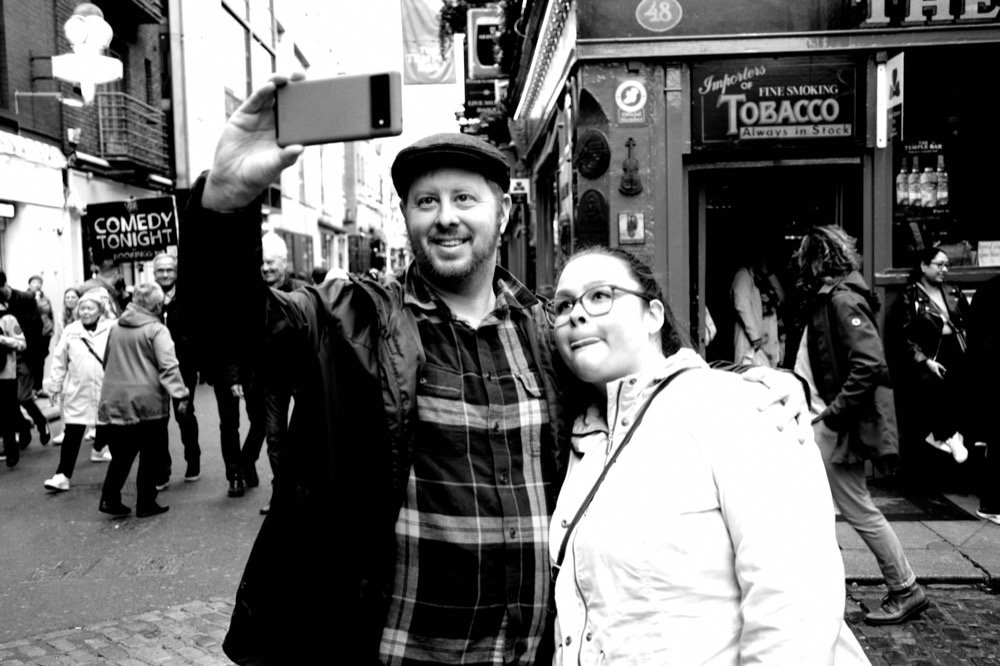A Day in Dublin: Photographing the Photographers
Shooting for Fun: The Joy and Unexpected Stories of Street Photography
Street photography is one of the purest forms of visual storytelling. It’s unfiltered, unscripted, and beautifully unpredictable. It doesn’t require models, studios, or elaborate setups—just a keen eye, a camera, and a willingness to embrace the unexpected.
For me, street photography has always been about fun. Not in a forced, entertainment-driven way but in the sense of adventure, discovery, and humour that comes with wandering through an unfamiliar city or even rediscovering my own backyard. The simple act of observing and capturing everyday moments can be an endless source of inspiration.
Unlike commercial photography, where the final image often has to serve a purpose—whether for a client, a brand, or a gallery—street photography is liberating. There are no rules. No one to please but yourself. That’s the beauty of it. You don’t have to justify what you shoot or why. You just follow your instincts, trust your curiosity, and let the world unfold in front of you.
A Day in Dublin: Photographing the Photographers
One of my favorite street photography experiences happened in Dublin, a city that pulses with energy. It was a crisp rainy afternoon, and the streets were alive—tourists laughing, musicians playing, locals weaving through the crowds.
As I wandered through the city, I started noticing something amusing: people photographing people. Tourists capturing landmarks, friends posing for each other, and strangers asking passersby to take their picture. It was a never-ending chain of people documenting their experience, only to become the subject of my own.
At one point, I saw a group of tourists huddled around a phone, intensely reviewing their shots like art critics at an exhibition. Just a few feet away, someone else was snapping a selfie with a statue. A couple was mid-argument over the best angle for a street performer. And then there was me, laughing to myself, capturing it all—photographing the photographers.
It was a moment of pure fun, a reminder that street photography doesn’t always have to be dramatic or thought-provoking. Sometimes, it’s just about capturing life’s little ironies.
Street Photography as a Social Commentary
While humor and lightheartedness often guide my approach, street photography also has the power to reflect deeper themes. Cities are constantly changing, and with them, so are the people. Gentrification, homelessness, political protests, cultural shifts—everything plays out in public spaces. A single frame can capture tension, joy, struggle, or resilience, sometimes all at once.
One of the most fascinating things about street photography is its ability to document history as it happens. Years from now, the images we take today will serve as a time capsule of how people lived, dressed, and interacted. I often think about the work of classic street photographers like Henri Cartier-Bresson or Vivian Maier, whose photos are now seen as historical records. What seemed like an everyday moment back then has become an iconic glimpse into the past.
Even my lighthearted “photographing photographers” moment in Dublin fits into that bigger picture. It speaks to how obsessed we’ve become with documenting our own lives. We pull out our phones and cameras everywhere we go, eager to capture the experience rather than live it. Are we truly seeing the world or just curating an idealized version for social media? Street photography forces me to ask these questions—not in a judgmental way, but with curiosity.
The Beauty of Imperfection
One of the biggest lessons I’ve learned in street photography is to embrace imperfection. Unlike studio or portrait photography, where everything can be controlled, the streets are chaotic. People move, light changes, and moments are fleeting. You don’t always have time to adjust your settings or get the perfect composition.
And that’s the point.
Some of my favorite street photos are technically “flawed” by traditional standards—slightly out of focus, motion blur, an awkward framing. But they feel alive. They capture movement, emotion, and authenticity. I’ve learned to stop deleting shots that aren’t razor-sharp because sometimes, the energy of the moment is more important than technical perfection.
Shooting for Yourself
There’s a lot of pressure in the photography world to create for an audience. Social media, competitions, and commercial work can turn photography into a job rather than a passion. But when I’m out shooting street photography, I remind myself: I do this for me.
Not every shot needs to be portfolio-worthy, and not every outing needs to result in a masterpiece. Sometimes, I go out and shoot 100 frames, only to delete them all later. And that’s okay. The joy is in the process, in observing the world differently, in experiencing moments I would have otherwise overlooked.
I shoot because I love it. It keeps me present and reminds me that life, in all its randomness, is worth capturing.
So if you ever find yourself wandering through a city with a camera in hand, don’t overthink it. Let yourself have fun. Shoot for the joy of it. And if you ever see a tourist posing dramatically in front of a landmark, take a step back—you might just find a story within the story.
And who knows? Maybe, just maybe, someone else will be photographing you photographing them.







